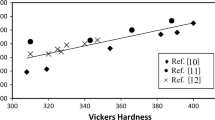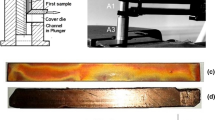Abstract
Although researchers have extensively investigated the dynamic mechanical properties of metallic materials at the macro-scale in terms of deformation mechanisms, strain rate strengthening and fracture mechanisms, they have rarely investigated the dynamic mechanical properties affected by size effects at the micro-/meso-scales. In this study, experiments on quasi-static compression and the split-Hopkinson pressure bar (SHPB) were conducted using oxygen-free high-conductivity (OFHC) copper with different geometrical and grain sizes to explore the size effects on various dynamic mechanical properties at the micro-/meso-scales. The experimental results showed that the quasi-static and dynamic mechanical properties of OFHC copper are affected by size effects at the micro-/meso-scales. In particular, OFHC copper was found to exhibit strain rate strengthening effects at the micro-/meso-scales, and the presence of micro-cracks was observed in the SHPB experimental specimens. In this study, after proposing a modified Johnson-Cook (J-C) constitutive model based on the surface layer model, we analysed the average relative error of the modified model and the original constitutive model. The influence of the size effect on the mechanical properties of materials is taken into account in the new modified constitutive model. The results of relative error analysis showed that the average relative errors for the original J-C model ranged from 3.2% to 18%, while the modified J-C model’s results ranged from 2.2% to 11%. The accuracy of the modified model is greatly improved. Following finite element analysis based on the modified J-C model and the original model, the results showed that the modified J-C model agreed well with the experimental results.














Similar content being viewed by others
References
Wang JL, Fu MW, Shi SQ (2017) Influences of size effect and stress condition on ductile fracture behavior in micro-scaled plastic deformation. Mater Design 131:69–80. https://doi.org/10.1016/j.matdes.2017.06.003
Ran JQ, Fu MW, Chan WL (2013) The influence of size effect on the ductile fracture in micro-scaled plastic deformation. Int J Plast 41(1):65–81. https://doi.org/10.1016/j.ijplas.2012.09.002
Wang JL, Fu MW, Ran JQ (2014) Analysis of size effect on flow-induced defect in micro-scaled forming process. Int J Adv Manuf Technol 73(9–12):1475–1484. https://doi.org/10.1007/s00170-014-5947-8
Fu MW, Wang JL, Korsunsky AM (2016) A review of geometrical and microstructural size effects in micro-scale deformation processing of metallic alloy components. Int J Mach Tool Manu 109:94–125. https://doi.org/10.1016/j.ijmachtools.2016.07.006
Fu MW, Wang JL (2021) Size effects in multi-scale materials processing and manufacturing. Int J Mach Tool Manu 167:103755. https://doi.org/10.1016/j.ijmachtools.2021.103755
Xu J, Wang XW, Wang CJ, Lin Y, Chen WJ, Bao JX, Su Q, Xu ZH, Wang CJ, Wang ZL, Shan DB, Guo B (2021) A Review on Micro/Nanoforming to Fabricate 3D Metallic Structures. Adv Mater 33(6):e2000893. https://doi.org/10.1002/adma.202000893
Xu J, Li JW, Shan DB, Guo B (2016) Microstructural evolution and micro/meso-deformation behavior in pure copper processed by equal-channel angular pressing. Mater Sci Eng, A 664:114–125. https://doi.org/10.1016/j.msea.2016.03.016
Li JW, Xu J, Guo B, Shan DB, Langdon TG (2017) Shear fracture mechanism in micro-tension of an ultrafine-grained pure copper using synchrotron radiation X-ray tomography. Scripta Mater 132:25–29. https://doi.org/10.1016/j.scriptamat.2017.01.021
Li JW, Xu J, Wang CT, Shan DB, Guo B, Langdon TG (2016) Microstructural Evolution and Micro-Compression in High-Purity Copper Processed by High-Pressure Torsion. Adv Eng Mater 18(2):241–250. https://doi.org/10.1002/adem.201500488
Jiang F, Lan Y, Hu ZW, Rong YM. (2013) Size Effect Analysis during Material Deformation with High Strain Rate. Key Engineering Materials, 589-590: 198-203.https://doi.org/10.4028/www.scientific.net/KEM.589-590.198
Tanner A B, McGinty R D, McDowell D L. (1999) Modeling temperature and strain rate history effects in OFHC Cu. International Journal of Plasticity, 15(6) : 575-603. https://doi.org/10.1016/s0749-6419(98)00062-x
Smerd R, Winkler S, Salisbury C, Worswick M, Lloyd D, FINN M. (2005) High strain rate tensile testing of automotive aluminum alloy sheet. Int J Impact Eng, 32(1-4) : 541-560. https://doi.org/10.1016/j.ijimpeng.2005.04.013
Liu Y, P Z C, L M, Wang Y G, Wang D, Song C H, Li S X. (2019) Investigation into the dynamic mechanical properties of selective laser melted Ti-6Al-4V alloy at high strain rate tensile loading. Materials Science and Engineering: A, 745: 440-449. https://doi.org/10.1016/j.msea.2019.01.010
Verleysen P, Peirs J. (2017) Quasi-static and high strain rate fracture behaviour of Ti6Al4V. Int J Impact Eng, 108: 370-388.https://doi.org/10.1016/j.ijimpeng.2017.03.001
Wang BF, Fu A, Huang XX, Liu B, Liu Y, Li ZZ, Zan X. (2016) Mechanical Properties and Microstructure of the CoCrFeMnNi High Entropy Alloy Under High Strain Rate Compression. Journal of Materials Engineering and Performance, 25(7) : 2985-2992.https://doi.org/10.1007/s11665-016-2105-5
Zhang CP, Chen S, Jiang ZL, Shi Z, Wang JL, Du LT. (2021) Highly Sensitive and Reproducible SERS Substrates Based on Ordered Micropyramid Array and Silver Nanoparticles. ACS Appl Mater Interfaces, 13(24) : 29222-29229.https://doi.org/10.1021/acsami.1c08712
Mao ZN, An XH, Liao XZ, Wang JT (2018) Opposite grain size dependence of strain rate sensitivity of copper at low vs high strain rates. Mat Sci Eng a-Struct 738:430–438. https://doi.org/10.1016/j.msea.2018.09.018
Wang WR, Li M, He CW, Wei XC, Wang DZ, Du HB (2013) Experimental study on high strain rate behavior of high strength 600–1000MPa dual phase steels and 1200MPa fully martensitic steels. Mater Design 47:510–521. https://doi.org/10.1016/j.matdes.2012.12.068
Johnson GR, Cook WH (1983) A constitutive model and data for metals subjected to large strains, high strain rates and high temperatures. [J] Eng Fract Mech 21:541–548
Khan AS, Huang SJ (1992) Experimental and theoretical study of mechanical behavior of 1100 aluminum in the strain rate range 10–5−104s−1. Int J Plast 8(4):397–424. https://doi.org/10.1016/0749-6419(92)90057-j
Farrokh B, Khan AS (2009) Grain size, strain rate, and temperature dependence of flow stress in ultra-fine grained and nanocrystalline Cu and Al: Synthesis, experiment, and constitutive modeling. Int J Plast 25(5):715–732. https://doi.org/10.1016/j.ijplas.2008.08.001
Molinari A, Ravichandran G (2005) Constitutive modeling of high-strain-rate deformation in metals based on the evolution of an effective microstructural length. Mech Mater 37(7):737–752. https://doi.org/10.1016/j.mechmat.2004.07.005
Shi H, Mclaren AJ, SELLARS C M, Shahani R, Bolingbroke R. (1997) Constitutive equations for high temperature flow stress of aluminium alloys. Mater Sci Technol 13(3):210–216. https://doi.org/10.1179/mst1997.13.3.210
Zerilli FJ, Armstrong RW (1987) Dislocation-mechanics-based constitutive relations for material dynamics calculations. J Appl Phys 61(5):1816–1825. https://doi.org/10.1063/1.338024
Follansbee PS, Kocks UF (1988) A constitutive description of the deformation of copper based on the use of the mechanical threshold stress as an internal state variable. Acta Metall Mater 36(1):81–93. https://doi.org/10.1016/0001-6160(88)90030-2
Nemat-Nasser S, Isaacs JB (1997) Direct measurement of isothermal flow stress of metals at elevated temperatures and high strain rates with application to Ta and TaW alloys. Acta Mater 45(3):907–919. https://doi.org/10.1016/s1359-6454(96)00243-1
Huh H, Ahn K, Lim JH, Kim HW, Park LJ (2014) Evaluation of dynamic hardening models for BCC, FCC, and HCP metals at a wide range of strain rates. J Mater Process Technol 214(7):1326–1340. https://doi.org/10.1016/j.jmatprotec.2014.02.004
Farahani HK, Ketabchi M, Zangeneh S (2017) Determination of Johnson-Cook Plasticity Model Parameters for Inconel718. J Mater Eng Perform 26(11):5284–5293. https://doi.org/10.1007/s11665-017-2990-2
Ducobu F, Riviere-Lorphevre E, Filippi E (2017) On the importance of the choice of the parameters of the Johnson-Cook constitutive model and their influence on the results of a Ti6Al4V orthogonal cutting model. Int J Mech Sci 122:143–155. https://doi.org/10.1016/j.ijmecsci.2017.01.004
Zhang DN, Shangguan QQ, Xie CJ, Liu F (2015) A modified Johnson-Cook model of dynamic tensile behaviors for 7075–T6 aluminum alloy. J Alloy Compd 619:186–194. https://doi.org/10.1016/j.jallcom.2014.09.002
Gambirasio L, Rizzi E (2016) An enhanced Johnson-Cook strength model for splitting strain rate and temperature effects on lower yield stress and plastic flow. Comput Mater Sci 113:231–265. https://doi.org/10.1016/j.commatsci.2015.11.034
Chan WL, Fu MW, Lu J, Liu JG (2010) Modeling of grain size effect on micro deformation behavior in micro-forming of pure copper. Mat Sci Eng a-Struct 527(24–25):6638–6648. https://doi.org/10.1016/j.msea.2010.07.009
Chan WL, Fu MW, Lu J (2011) The size effect on micro deformation behaviour in micro-scale plastic deformation. Mater Design 32(1):198–206. https://doi.org/10.1016/j.matdes.2010.06.011
Zhang B, ShimV PW (2010) Determination of inelastic heat fraction of OFHC copper through dynamic compression. Int J Impact Eng 37(1):50–68. https://doi.org/10.1016/j.ijimpeng.2009.07.003
Jordan JL, Siviour CR, Sunny G, Bramlette C, Spowart JE (2013) Strain rate-dependant mechanical properties of OFHC copper. J Mater Sci 48(20):7134–7141. https://doi.org/10.1007/s10853-013-7529-9
Zoller K, Schulz K (2020) Analysis of single crystalline microwires under torsion using a dislocation-based continuum formulation. Acta Mater 191:198–210. https://doi.org/10.1016/j.actamat.2020.03.057
Fan HD, Wang QY, EL-Awady J A, Raabe D, Zaiser M (2021) Strain rate dependency of dislocation plasticity (vol 12, 1845, 2021). Nat Commun 12(1):1–11. https://doi.org/10.1038/s41467-021-22963-x
Qin K, Yang LM, Hu SS (2009) Mechanism of Strain Rate Effect Based on Dislocation Theory. Chin Phys Lett 26(3):036103. https://doi.org/10.1088/0256-307x/26/3/036103
Kapoor R, Nemat-Nasser S (1998) Determination of temperature rise during high strain rate deformation. Mech Mater 27(1):1–12. https://doi.org/10.1016/S0167-6636(97)00036-7
Lai XM, Peng LF, Hu P, Lan SH, Ni J (2008) Material behavior modelling in micro/meso-scale forming process with considering size/scale effects. Comput Mater Sci 43(4):1003–1009. https://doi.org/10.1016/j.commatsci.2008.02.017
Funding
The authors gratefully acknowledge funding supported by the Young Scholars Program of Shandong University, Shandong Provincial Natural Science Foundation (ZR2019BEE062), China Postdoctoral Science Foundation (2021M691926), Natural Science Foundation of Jiangsu Province (BK20190202), Research Project of State Key Laboratory of Mechanical System and Vibration (MSV202102).
Author information
Authors and Affiliations
Contributions
Chuanzhi Jing was responsible for writing these papers and FE simulation. The Corresponding author Jilai Wang was responsible for proposing methods and planning experiments. Chengpeng Zhang and Zhenyu Shi were responsible for experiments and data collection. Yan Sun was responsible for data processing and measuring work.
Corresponding author
Ethics declarations
Ethical approval
Not applicable.
Consent to participate
Not applicable.
Consent to publish
Not applicable.
Competing interests
The authors declare that they have no known competing financial interests or personal relationships that could have appeared to influence the work reported in this paper.
Additional information
Publisher's Note
Springer Nature remains neutral with regard to jurisdictional claims in published maps and institutional affiliations.
Rights and permissions
About this article
Cite this article
Jing, C., Wang, J., Zhang, C. et al. Influence of size effect on the dynamic mechanical properties of OFHC copper at micro-/meso-scales. Int J Adv Manuf Technol 120, 4775–4789 (2022). https://doi.org/10.1007/s00170-022-08674-7
Received:
Accepted:
Published:
Issue Date:
DOI: https://doi.org/10.1007/s00170-022-08674-7




